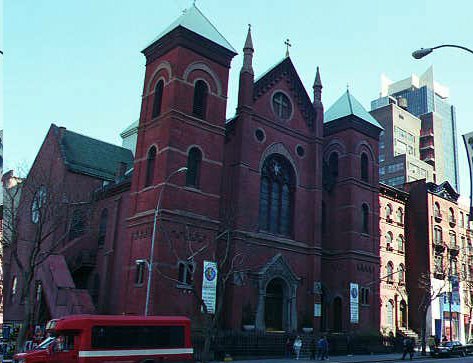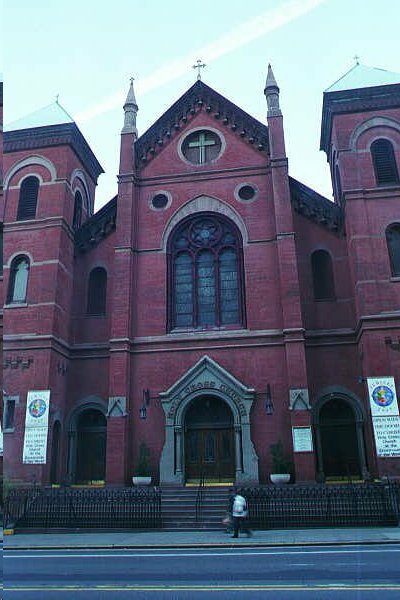

Thanks to: Catholic New York Feature Story
March 08, 2001
Building Up
Locals wary as plans afoot to develop Manhattan's West Side
By JOHN BURGER (picture Fr. Tomas)

The Leonard Bernstein musical "West Side Story" was a drama of warring gangs in the tough Hell's Kitchen neighborhood of the 1950s. But on today's West Side, the Jets are the football team looking to build a stadium, and the Sharks are real-estate moguls eyeing some of the borough's juiciest parcels.
And the rush to develop the West Side with luxury condos, office towers, hotels and attractions has pastors, community activists and individuals calling for caution. Gentrification could raise rents so much that the poor will be excluded and churches could lose their parishioner base of working-class people and families with school-age children. Some locals fear the loss of neighborhood character and the passing of a way of life.
"You have to be cautious of gentrification, to make sure rental prices don't go too high," said Father Peter M. Colapietro, pastor of Holy Cross parish. "We have a lot of poor and marginal people who won't have a place to live."
Father Colapietro, who serves on the Mayor's Midtown Citizens Committee, an advisory group of business, theater and church leaders, added that a substantial amount of housing, where people have lived all their lives, needs rehabilitation. "People are sharing bathrooms on the same floor," he said.
Holy Cross, which is across from the Port Authority Bus Terminal, serves homeless people out of a food pantry on Sundays.
New residential skyscrapers already have sprouted near the West Side Highway, and neighborhoods stretching from 30th to 59th streets, from Eighth Avenue to the Hudson River--including northern Chelsea and Clinton--have been cleaned up of much of the porn emporiums, street-walking and drug dealing that once blighted those areas.
Leon Shilton, a professor of finance and real estate at Fordham University's Manhattan campus, traces the development of the West Side to the clean up of the West Side Highway which, several years ago, was a "random piece of junk," he said.
When plans for Westway--a new highway to replace part of the West Side Highway, and developments on landfill in the Hudson River--were scrapped, investors who had bought property nearby began to look eastward to fulfill their real-estate dreams, Shilton said. Now, he predicts, there will be major pressure to change zoning regulations on the West Side to allow taller buildings. The city's Department of City Planning has proposed rezoning the manufacturing district west of 10th Avenue, between 28th and 42nd streets, to allow skyscrapers.
Developers are also trying to buy air rights from neighbors in order to build higher. There are plans to build a 40-story residential tower next to Holy Cross Church on 42nd Street, between Eighth and Ninth avenues, with a connecting seven-story tower fronting 43rd Street, near the parish school. The developers have expressed interest in the parish air rights, but no deal has been reached yet, said David S. Brown, director of the archdiocesan Real Estate Division.
The developers, Bernard and Robert Friedman, have applied for up to $115 million in Housing Finance Agency bonds and would be required to set aside 20 percent of the 320 units for lower-income families. Such buildings are known as 80-20 developments.
The New York Jets have proposed building a 75,000-seat, retractable-dome stadium and an expansion of the Jacob K. Javits Convention Center. Such a structure would dominate an area of old low-rise apartment buildings and parking lots, taxi repair shops and old factories.
"People are saying, 'Don't give us a stadium; give us housing,' " said Ray Frier, who represents Holy Cross on the Clinton Housing Association, a community group that helps build affordable housing. He would like to see developers provide low-income housing based on the premise that those in service jobs who live close to their work will be better employees.
"I think you could turn this into a good business position, not just a moral one," said Frier, a public relations consultant.
Alice Parsekian, a member of St. Michael's parish, agrees: "You hear about the need for 50,000 more teachers in the New York City school system," she said. "I say they need 50,000 more apartments in the city for them."
Frier would also like to see more developers do what Manhattan Plaza Apartments, where he lives, did when it opened years ago--give priority to people who have been living in the neighborhood for years.
"This is our home," he said of the area. "But most developers don't look at it as a community; they see it as a commercial space."
One Catholic-sponsored entity which has responded to the need for housing is Encore Community Services of St. Malachy's parish in the Theater District. Encore recently won an $8.4 million grant from the federal Department of Housing and Urban Development to build an 85-unit residence for low-income elderly. The building will go up on Tenth Avenue between 51st and 52nd streets, part of the Clinton Urban Renewal Area.
"We'd like to see a mixed use community in Clinton," said Sister Elizabeth Hasselt, O.P., Encore's executive director. "There has to be more housing for lowand moderate-income, the working backbone of this city.
"We've worked long and hard to save this community for the people who have lived here," Sister Elizabeth said. "It's not that we don't want new people, but it's that mixture that makes New York City unique."
Encore, which provides a variety of services for some 14,000 senior citizens each year, has built other residences and has recently helped about 120 people move in to a new 80-20 nearby.
"For the Church to survive here, we've got to find housing for parishioners," adds Mary D'Elia, a founding member of a revitalization group, the Clinton Association for a Renewed Environment, which meets weekly at her parish, Sacred Heart on West 51st Street. She noted the almost impossible situation for most parents who pay high rents and want to send their children to Catholic schools.

Father Kevin J. Nelan, pastor of Sacred Heart, said that most students come from the lower middle class, and their parents pay $2,000 in tuition at Sacred Heart School.
New York City is bidding to host the 2012 Olympics, and having a new stadium would help its chances. The proposed stadium, which also could be used for political conventions and concerts, would cost more than $1 billion, with taxpayers picking up at least two-thirds of the cost.
Most residents interviewed by CNY are concerned about the amount of traffic a stadium would bring. Rush hour is already a mess near the approaches to the Lincoln Tunnel, the Port Authority Bus Terminal and the West Side Highway.
Some, like Lili Fable, are not so quick to dismiss a stadium. "My husband thinks it's a great idea. It would be wonderful if you could walk to a game," said Mrs. Fable, whose Poseidon Bakery on Ninth Avenue between 44th and 45th streets is the kind of small, family-run emporium that gives character to the West Side. Her family has been making Greek spinach pies and baklava there for 77 years.
Mrs. Fable said the proposal has come up only once so far before the Mayor's Midtown Citizens Committee, of which she is a member. "After an environmental impact study, we'll know more," she said. "It's still too new."
A member of Holy Cross parish, she said that some West Siders rejected the idea out of hand. "Some people say no to everything," she
commented. But the proposal has one thing going for it: It would be built on a platform over the 30-acre West Side rail yards between 11th and 12th avenues and 30th and 34th streets, so no homes would have to be displaced, she pointed out.
Msgr. Donald Sakano, pastor of Holy Innocents in the garment district and a former housing official in Catholic Charities, hopes that planning will provide for the mix of income levels that "every viable city has."
"The West Side has been a working-class neighborhood with a good dose of actors and people in the entertainment profession," he said. He also feels that the architecture of high-rise apartment buildings does nothing to encourage people to feel part of a neighborhood or family life.
"I don't know how many developers are building twoand three-bedroom apartments," added Msgr. Marc J. Filacchione, pastor of St. Michael's parish. Couples who start out with small apartments in the city usually move to more affordable areas when they have children and need more room, he said.
St. Michael's, on 34th Street, west of Ninth Avenue, is the Catholic church closest to the rail yards, and Msgr. Filacchione, who lives right outside an entrance to the Lincoln Tunnel, also wonders how stadium planners would handle added traffic.
A city proposal for the Olympics includes rail links, an extension of the No. 7 subway line south from Times Square and a ferry terminal. Officials also plan to redesign access to the tunnel as part of an estimated $2 billion in transportation improvements.
But locals are still wary. A stadium would attract people from all over the metropolitan area, and those who live in the suburbs and outer boroughs of the city tend to be "car-oriented," Mary D'Elia said.
A possible windfall for St. Michael's, however, would be the moving of Pennsylvania Station one block west into the James A. Farley General Post Office. That would mean that an exit at 33rd Street and Ninth Avenue would be less than a block away from St. Michael's, possibly increasing daytime traffic and Mass attendance and making it more of a
commuter church like St. John the Baptist, just south of the current Pennsylvania Station.
Father Slaven H. Mijatovic, O.F.M., pastor of SS. Cyril and Methodius and St. Raphael parish, already is seeing an increase in traffic at his church because of developments in the area. The parish attracts Croatians from all over the metropolitan area and offers two Sunday Masses in Croatian and one in English. As workers lay the foundation for another high-rise across the street from the church on 41st Street and 10th Avenue, Father Mijatovic is considering adding a daily Mass at noon.
He is also hoping that the owner of an auto shop and lot next to the church will tidy the place up. If West Side gentrification continues the way it's been going, perhaps that too will come.
Pastors Holy Cross Espaņol Holy Cross English Index Espaņol English Index